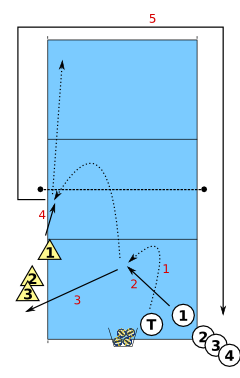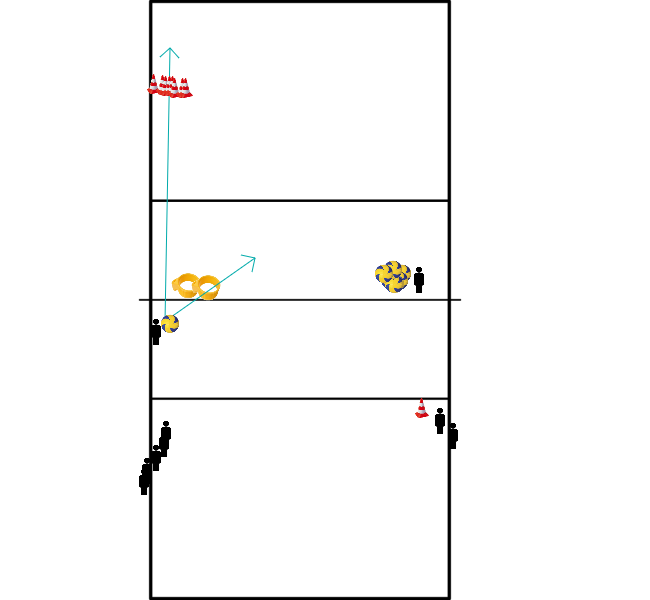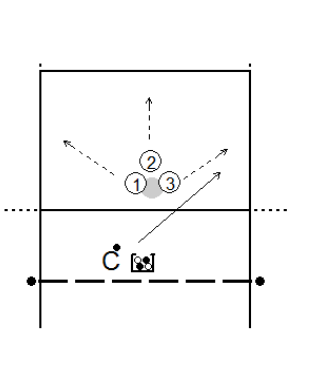Volleyball drills for technique attack / smash / spike / hitting
This exercise is about another player taking over the setup.
The players are divided into two groups. One group is lined up in the front left corner ready to attack. The players of the other group line up in the back right of the field.
- The trainer bounces the ball high somewhere in the field (1).
- The player gives a high setup to the outside left (2) and then gets in line at the front left (3).
- The first player on the front left smashes the ball (4) and retrieves it himself in order to join the back row on the right (5).

- three people in the field.
- Coach hits the ball into the field
- then sets it up in three
- over the net
- who plays the ball over the net retrieves it and puts it in the cart.
- 4 players are in the line-up. 1 of the players SV.
- 3 other players serve.
- Perfect pass to SV
- SV plays behind 3 meter line for attack.
- 10 balls change.
- team is in line.
- serve on team
- team builds attack, completes it.
- Coach plays next ball immediately,
- 4x in quick succession.
- Service
- Pass to mid-forward on 2 or 4,
- Attack quickly on 3 or long ball to 4 or 2, or......3 meter attack
- advantage of variation of the playmaker,
- and attack is shifted to other side,
- difficult to defend,
- and mid-forward opponent must defend in the block.
Goal of the exercise:
Fine tuning techniques
Explanation of the exercise:
- From the right front, balls are hit on the own half to position 4 / 5.
- The defender attacks his own ball again.
- Follow your own ball. N
- After your attack you start serving from position 5 straight ahead.
4 game forms for warming-up for youth teams.
Game form 1: ( Korfvolley )
- Theme of the training: Playing above the head
- Explanation:
- A game of Korfball, same rules, but it is only allowed to score with an overhand ball.
- More difficult:
- The ball must be pinned by a team mate.
- Easier:
- Draw a circle around the basket, where only the attacking team is allowed to go.
- Scoring:
- 1 point for every ball scored
- 2 points for a teammate who passes the ball to the attacker.
Game form 2: ( Basketball volleyball )
- Theme of the training: Playing with hands
- Clarification:
- Make 1 group per basket and throw the ball under a left or right angle from under the basket.
- The players have to play the ball underhand in the basket.
- Harder:
- Hit the ball in a controlled way instead of throwing it in.
- Catch the ball before it hits the floor via the basket.
- Easier:
- Throwing the ball straight instead of in an angle.
- Reduce the distance to the basket.
- Point count:
- 1 point for every scored ball
- 2 points for a passed ball
- 3 points if the ball is caught in follow-up.
Game form 3: ( Tennisvolley )
- Theme of the training: attack
- Explanation:
- Tension the net at tennis height and make teams of 3 or 4 players.
- The ball must be played back and forth and smashed into the ground on your own side.
- The receiving side may not let the ball bounce first.
- Turn over every time the ball is played to the other side.
- You will see that this is a very difficult exercise when the ball lane recognition is not in order.
- Harder:
- Jump on attack
- Easier:
- No spin
- Ball may not end within 3 meters
- Point count:
- 1 point for every scored ball
Game form 4: ( Trefvolley )
- Theme of the training: Defence
- Explanation:
- Game of dodgeball where all the defensive techniques of volleyball are allowed as defence.
- Player throws the ball to his opponent, who tries to defend the ball so his teammate can catch it.
- Harder:
- Field must be divided into front and backfield, catching teammate must be in the frontfield.
- Thrown ball must be a batted ball.
- Easier:
- Throw with 2 hands from the neck.
- Throw with 2 hands from the chest.
- Point count:
- 1 point for every ball defended
General:
- The warm-up for youth should be playful and always with the ball.
- Do not warm up too much, stretch, play volleyball immediately.
- On one side of the net there are 6 players. (If they are having trouble with the set up, the trainer can take over this spot).
- The remaining players stand on the other side of the net.
- They start the game, by serving.
- The 6 players build an attack. Pass/Set up/Smash.
- Just play the point.
- Full turn at the smash.
- Communication by calling LOS, good pass.
- The goal of this exercise is to tactically put away or hit the ball.
- This by means of a tap ball on midmid, or a ball deep on position 1.
- By using baskets you can create a 'constant' block, which eventually can be replaced by a real block.
- The pawns at position 1 can best be replaced by a cupboard, over which the ball must fall, over the 'defender'.
- The trainer hits a ball, or plays a ball in, which is first passed to the distributor,
- the playmaker gives a set-up to the outside.
- The attacker decides whether to try a short passed ball at midmid (where there is a hoop),
- or looks for position 1 with a hit or a fast overhand ball.

- All on the back line
- two walk to the net
- make a block jump
- and go backwards again
- the coach puts the ball in play
- and they set up an attack.
- 1, 2, and 3 start in the middle
- C bounces the ball and the players move to their defensive positions.
- C attacks one of the defenders.
- after the defence, set-up and 3 meter attack
- after 5 times a new 3

- A line-up of six players stand in the field.
- On the other side stands the trainer, included if necessary.
- Three players stand at the net with 1-2 balls and one server stands (this can also be the trainer).
- The first ball is served and handled by the 6 players.
- Where the attack is played, the person standing with the two balls at the net, throws the ball back over the net very quickly.
- In this way the attacking cover is trained.
- From this cover, all attackers must of course return as quickly as possible to give support.
- A short run is important.
- You will therefore be training a lot of blocking without actually blocking
- Keep on blocking until the net players have run out of balls, until it is not safe or until they simply cannot play anymore.
- Rotate through a position every so often so that side-out is trained on every position.
- After throwing the ball, the net players should look back to make sure that the previous ball doesn't secretly roll back under the net.







